How to Build an Integration 1st Product: The Strategy And Developer Portal
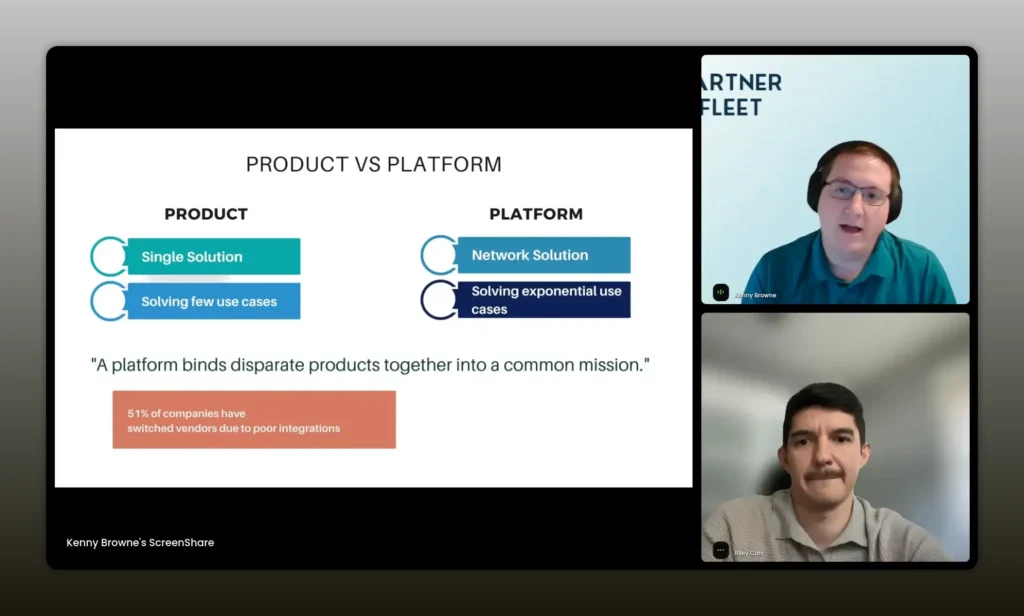
Expert advice from Kenny Browne and Riley Carr.
Introduction
Whether your solution connects with an existing tech stack ranks among the top three buying considerations. That means integrations are not optional features; they are strategic assets that influence acquisition, retention, and growth. If you want to move from being a standalone product to a platform that scales, you need a deliberate integrations strategy, the right infrastructure, and a partner-first mindset.
Whether or not it works with their existing tech stack is a top three buying consideration. -Kenny Browne
Table of Contents
- Why integrations matter right now
- Product versus platform: which path are you on?
- Four ways to launch integrations
- Decision matrix: when to build, buy, or open up
- The developer and partner journey: the eight-step flow
- Case study: G2’s developer portal and the self-service push
- Seeding your marketplace: lessons from Slack
- Security, legal review, and app submission
- Driving discoverability and adoption
- Measuring impact and reporting
- Common pitfalls and how to avoid them
- Tactical checklist and launch playbook
- Partner program directory and growth channels
- FAQs
- Conclusion
Why integrations matter right now
Integrations are a decisive issue for buyers. Which means, you should care about them because:
- Buyer evaluation is digital. About 70 percent of the buyer’s journey happens before a human interaction. Buyers research on review sites, check partner pages, and consult search engines and AI tools to make shortlists.
- Tech stack fit drives shortlisting. For SMBs and mid-market, integrations can be the single most important criterion after core functionality. For enterprises, integrations sit just behind security in importance.
- Integrations increase retention. Real-world data shows customers who adopt one integration renew at higher rates than those who adopt none. Customers with multiple integrations often retain at dramatically higher rates.
Those are not soft outcomes. Integrations directly affect conversion, churn, and expansion. If you want to increase customer lifetime value and win in a crowded category, you need to make integration a product and a business priority.

Customers with four or more renewed at a 135% higher rate than customers with zero. -Kenny Browne
Product versus platform: which path are you on?
There is a practical difference between building a product and building a platform. This is not just language; it changes priorities, KPIs, and organizational structure.
- Product: A single-solution focus that aims to solve a narrow set of use cases with deliberate feature investments. If you are primarily a product company, you will prioritize high-demand integrations that unblock sales or core user value.
- Platform: A network approach that solves exponential use cases by binding disparate products together under a shared mission. Platforms think in flywheels: more partners create more value, which attracts more customers, which attracts more partners.
If your leadership wants to win a category as an ecosystem, top-down alignment is required. The ecosystem must be treated like a product: product management, partnerships, engineering, legal, and executive sponsorship all need to be aligned.
Four ways to launch integrations
There are four pragmatic approaches you can use, often in combination, depending on your stage and strategy.
1. Build in-house
When to use it: for core systems where you must own the UX and reliability. Typical examples are CRM integrations, single-sign-on, or deeply embedded revenue workflows.
Pros:
- Deep control over data model and user experience
- Ability to solve complex edge cases
- Perceived higher quality by enterprise buyers
Cons:
- Slow to ship: average integration efforts often take at least three months
- Engineering becomes a bottleneck
- Ongoing maintenance cost for every integration you own
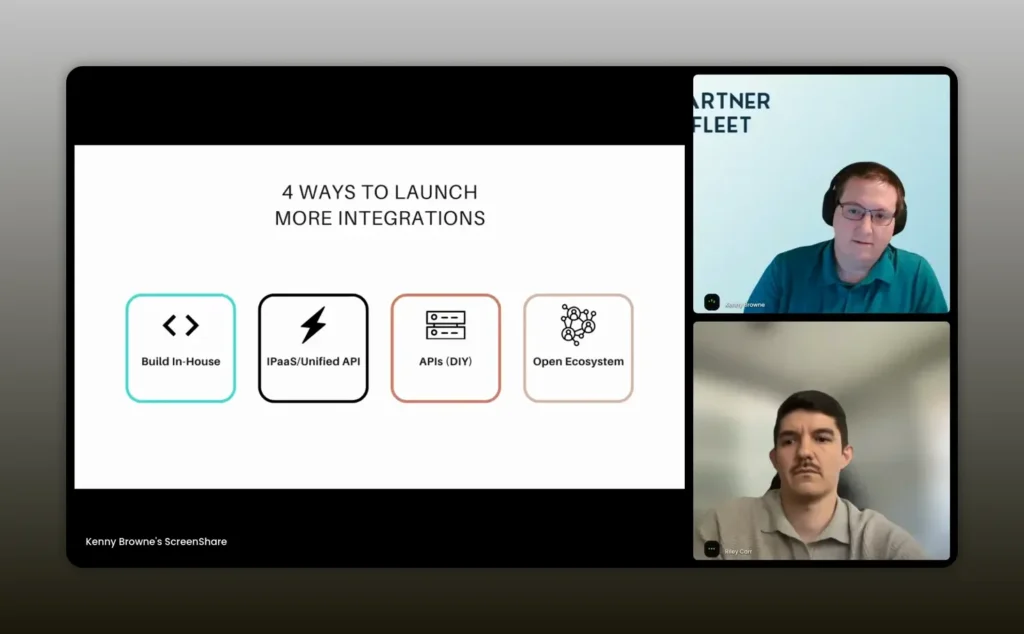
The average integration takes at least three months to build. -Kenny Browne
2. IPaaS (integration platform as a service) and unified APIs
When to use it: when you need breadth quickly and your integrations can be shallower. IPaaS solutions like Zapier or Tray.io let you connect many endpoints with less engineering effort.
Key distinctions:
- IPaaS is typically transactional. It passes data between systems with some transformations and can get you live faster for many endpoints.
- Unified APIs often act as a facade and may cache or store data centrally before pushing to downstream systems. That changes operational considerations and SLAs.
Reality check: IPaaS can be a powerful tool in your toolbox, but it rarely scales as the sole solution for a platform. Many organizations launch five to ten integrations through IPaaS successfully, but they find scaling to hundreds requires additional investment.
3. Expose APIs and enable DIY integrations
When to use it: you’ve seeded core integrations and now want partners and customers to build the rest.
Pros:
- Exponential potential — partners build where it makes sense for them
- Reduced direct engineering and maintenance burden
Cons:
- If you only publish raw API docs, adoption will be limited
- You still need infrastructure: developer portals, credentials, sample code, and sandbox data
Publishing an API is not the end game. You must think about developer experience, legal, security, and how partners discover and monetize integrations.
4. Full ecosystem and marketplace
When to use it: you are pursuing platform-level growth and want partner-driven expansion.
This step requires significant operational infrastructure: app submission workflows, legal review, security vetting, discovery pages or marketplaces, user self-service toggles, and reporting for partner value. Treating the ecosystem as a product is mandatory at this stage.
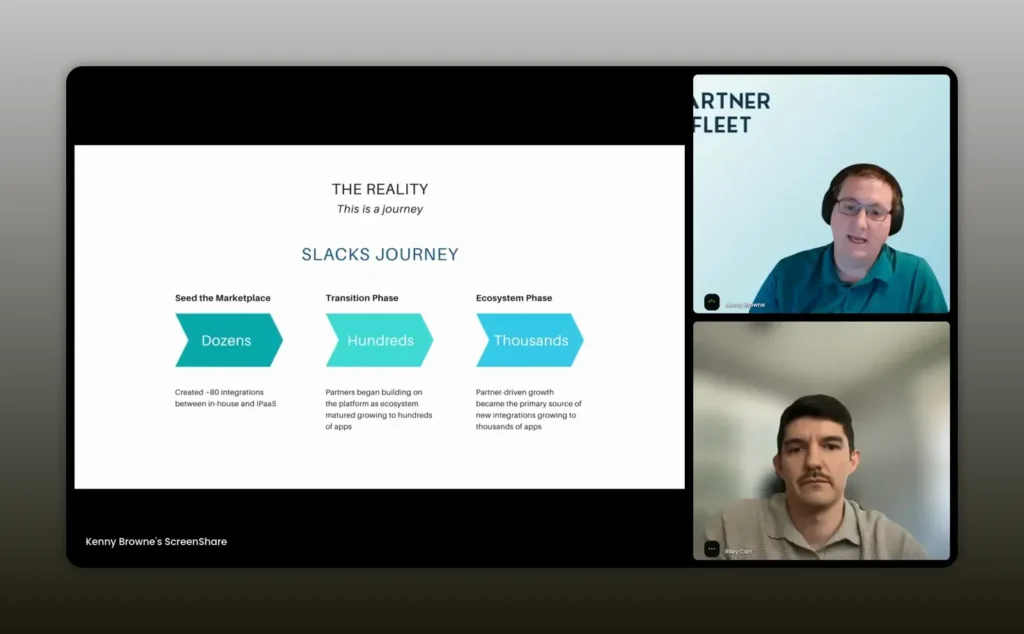
They actually built around 80 integrations in-house and through iPass before they opened it up. -Kenny Browne
Decision matrix: when to build, buy, or open up
Think of integration choices along two axes: value to your business and demand from customers.
- High value, high demand: build in-house. Examples: HubSpot, Salesforce, major CRMs.
- High value, lower demand: consider IPaaS or a targeted in-house build if justified.
- Lower value, high or low demand: let partners or customers build it against your API, or rely on an IPaaS integration.
Remember that what is low value to you might be high value to a partner. Partners perform their own ROI calculations. If you expose a clean API and a great developer experience, you’ll attract builds that you didn’t have to prioritize internally.

Building integrations in‑house gives you the control and depth enterprise buyers expect — but it’s slow, creates engineering bottlenecks, and saddles you with ongoing maintenance. -Kenny Browne
The developer and partner journey: the eight-step flow
Your integration infrastructure must map to the real sequence that external developers and partners follow. These steps are the minimum to deliver a self-service ecosystem that scales:
- Sign up and create an organization account
- Obtain API credentials or register an OAuth app
- Access clear documentation and sample code
- Use sandbox data to test calls and flows
- Submit the integration for review (security, data use, legal)
- Receive approval and marketplace listing
- Enable end-user discovery and self-installation
- Measure usage and business impact
Many companies stop at step three and assume openness is solved. It is not. The missing steps are where deals can break, where security problems arise, and where the friction kills partner momentum.
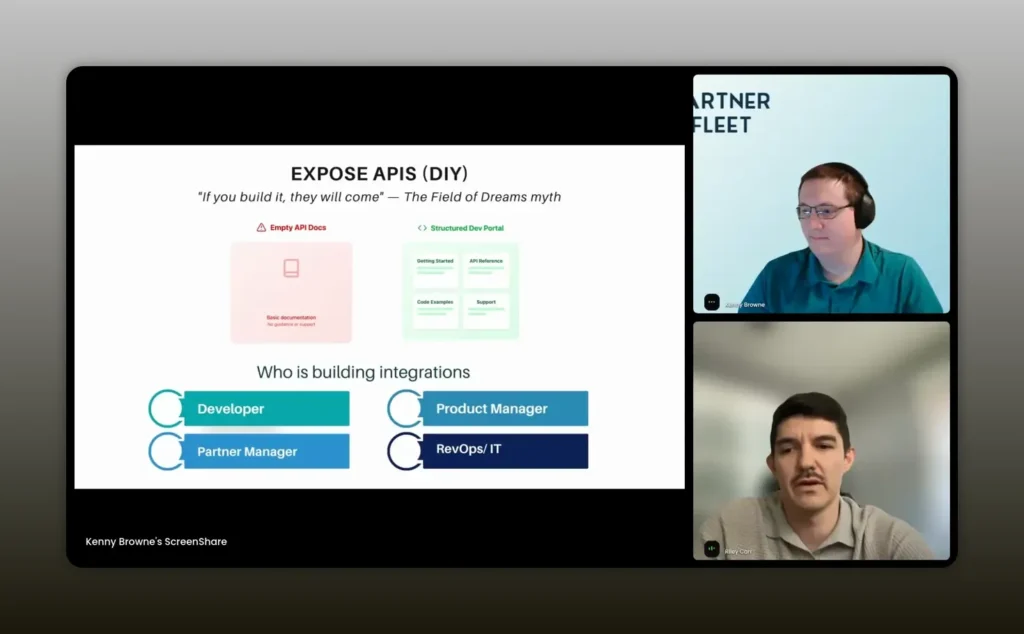
This process allows self-service creation of your organization, API tokens, OAuth apps, and allows you to begin testing your integration immediately. -Riley Carr
Case study: G2’s developer portal and the self-service push
G2 took a deliberate approach to move from manual, resource-intensive partner work to self-service scale. Their goals were clear:
- Make review data available as widely as possible through a “G2 Everywhere” approach
- Automate the onboarding and developer experience so partners can start building immediately
- Provide sample code and sandbox data to speed up the first API calls
Riley Carr drove the creation of a centralized developer portal that allows partners to register organizations, create API tokens, and test integrations without contacting support. That removed a major friction point.
They also recognized areas where third-party help was necessary. While the developer experience was internally built, the legal and app submission workflows were offloaded to Partner Fleet to reduce the operational load and improve time-to-approval.
Today, G2’s approach illustrates a hybrid model: build the core developer UX in-house and partner with specialists for scaled partner operations and submission management.
Seeding your marketplace: lessons from Slack
Even the most successful marketplaces were not partner-driven from day one. Slack seeded their marketplace by building the first several dozen integrations themselves and using IPaaS to accelerate coverage. The timeline looked like this:
- Seed with in-house builds and IPaaS to reach critical developer utility
- Open APIs to partners once a baseline of integrations exists
- Transition to partner-first and scale to hundreds and eventually thousands of integrations
The lesson is simple: you often have to invest up-front to reach a tipping point. That investment might be engineering time, IPaaS spend, or curated partnerships that create early demonstrable value. Once demand and discovery mechanisms exist, partner-built integrations accelerate growth exponentially.
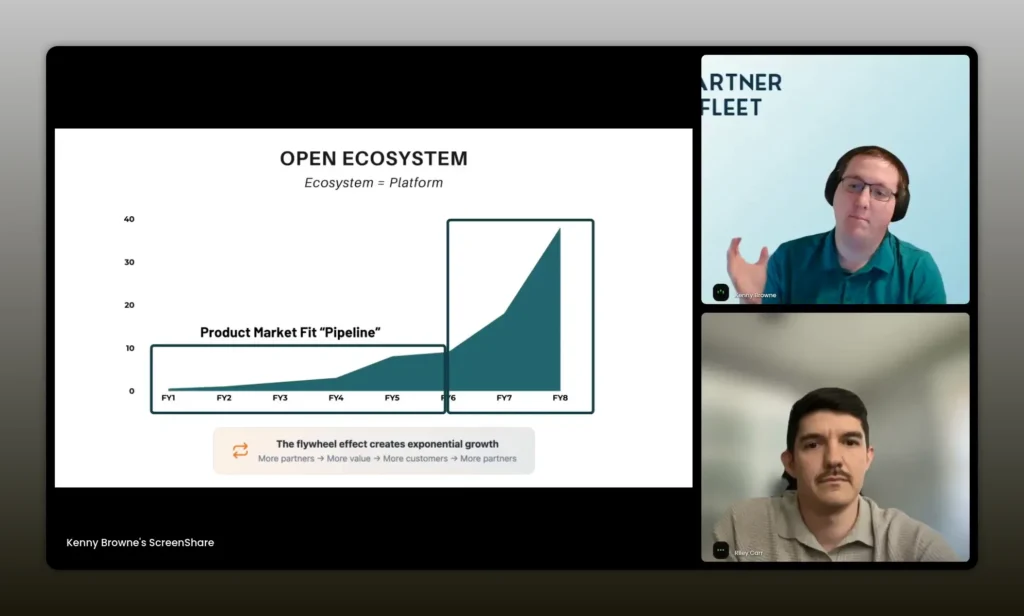
What if you could then attract and make it easy for developers to build into yours? -Kenny Browne
Security, legal review, and app submission
Opening your ecosystem introduces third-party risk. That risk is not hypothetical. Partners sometimes mishandle credentials, mis-configure access, or publish code that leaks secrets. You must build guardrails:
- App submission and vetting: require a formal application and review process. Don’t accept integrations to your marketplace without approval.
- Legal agreements: require partners to sign terms that cover data use, security responsibilities, and indemnity where appropriate.
- Secrets management: prefer OAuth flows and short-lived tokens over static API keys. Offer clear guidance and automatic rotation capabilities.
- Sandbox and least-privilege testing: provide realistic but constrained sandbox data so partners can test without risking production data.
Failing to do this puts your customers at risk and can create downstream legal and reputational consequences. The app submission process is an operational feature, not just a bureaucratic hurdle.
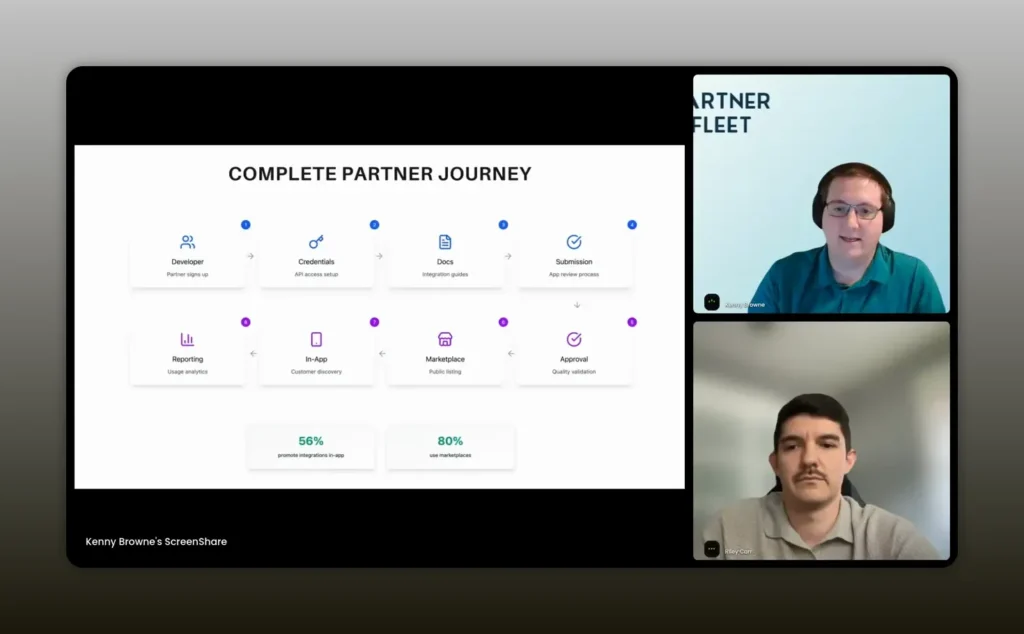
You need a submission process. You need to review them from a legal perspective. Make sure they’re signing any terms and conditions. -Kenny Browne
Driving discoverability and adoption
Once you have integrations, people must find and use them. A marketplace is only useful if it is discoverable and simple for end users to enable integrations inside your product and from public listings.
Key levers to increase adoption:
- Marketplace listing pages: include clear descriptions, use cases, screenshots, and installation instructions.
- In-app integration center: provide an integration tab or marketplace inside the product so existing customers can enable integrations without leaving the app.
- Search and SEO: optimize partner listings for the terms buyers use when researching tech stack compatibility. Keywords like integrations, marketplace, connectors, and your major partner names should be used naturally.
- Marketing and co-marketing: promote top integrations with case studies, how-to content, and joint webinars with partners.
Remember: building integrations and publishing them is only half the equation. Active marketing and product hooks determine adoption ratios.
Measuring impact and reporting
You need to instrument and report on integration usage to connect partner activity to business outcomes. Core metrics to track:
- Number of integrations enabled per customer
- Attach rate: percentage of customers using at least one integration
- Revenue or renewal uplift correlated to integration usage
- Partner-sourced pipeline or customer acquisitions
- Monthly active integrations and error rates
Use dashboards that link integration adoption to revenue and retention. These reports are essential to justify continued investment in integrations and to reward partners that drive meaningful value.
Common pitfalls and how to avoid them
Scaling an ecosystem is non-trivial. Here are common mistakes and how to avoid them:
- Mistake: Publishing raw API docs and expecting partners to come. Fix: Build onboarding flows, sample apps, and sandbox data.
- Mistake: Treating integrations as a side project owned by engineering. Fix: Create a cross-functional product for ecosystem, with partnerships and executive sponsorship.
- Mistake: Ignoring legal and security workflows. Fix: Implement app submission, vetting, and enforce best practices for keys and tokens.
- Mistake: Not measuring integration ROI. Fix: Track attach rates and revenue lift per integration and report to leadership.
Tactical checklist and launch playbook
Use this checklist to move from idea to a self-service ecosystem:
- Define your ecosystem strategy and secure executive buy-in
- Prioritize the first 8 to 12 integrations: identify high-value, high-demand systems to build in-house
- Choose IPaaS vendors for interim coverage
- Design and build a developer portal with self-service token creation and sandbox data
- Create sample code in multiple languages and quickstart guides
- Design an app submission, legal review, and security vetting workflow
- Launch a marketplace and in-app integration center with SEO-optimized listings
- Measure adoption and impact; iterate on documentation and product hooks
- Recruit partners and run co-marketing programs for top integrations
- Scale operations with partner management tooling or a partner operations provider
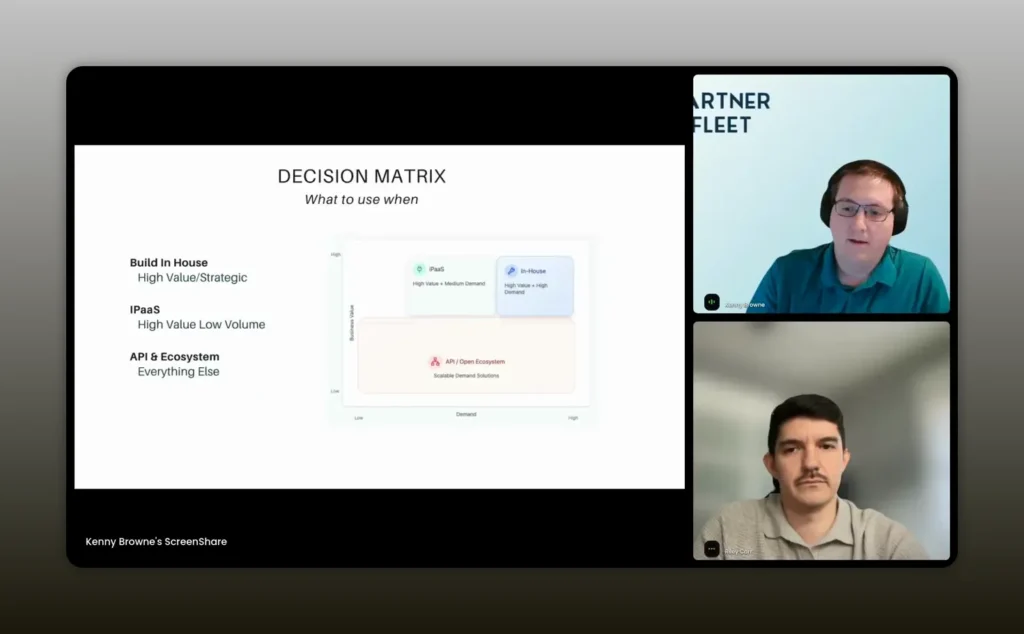
A lot of companies will use IPaaS as a tool in their tool belt, but IPaaS generally tries to sell themselves as the entire tool belt. -Kenny Browne
Partner program directory and growth channels
Visibility matters. A partner program directory that lists companies with ecosystems and partner programs helps buyers find compatible tools and helps partners identify collaboration opportunities. If you have a partner program, claim and list it in public directories to increase discovery.
Channels that accelerate ecosystem growth:
- Partner directories and marketplaces
- Joint marketing and case studies
- Technical design partners and community hackathons
- Developer advocacy and sample apps that showcase integration patterns
Consider partnering with a firm that helps manage application intake and approvals if you want to offload the operational burden and accelerate partner onboarding.
FAQs
What are the four primary ways to launch integrations?
You can build in-house for strategic, high-demand integrations; use IPaaS or unified APIs for broader but shallower coverage; expose APIs and enable partners and customers to build DIY integrations; or build a full ecosystem and marketplace that supports partner-driven growth.
How do I decide which integrations to build in-house?
Prioritize integrations that are core to your value proposition or required for sales conversion—CRMs, single-sign-on, and key revenue systems. Use a decision matrix of value versus demand to guide choices.
What must a developer portal include to be effective?
At minimum, a self-service registration flow, API credentials (tokens and OAuth), clear documentation, sample code in multiple languages, and sandbox data for testing. Quickstarts and onboarding walkthroughs drastically reduce time to first successful API call.
When should I seed the marketplace myself?
If partner interest is low and buyer expectations require certain integrations, seed the marketplace by building the first set of integrations in-house or via IPaaS. This creates initial utility and a discovery surface for partners.
How do I manage security and legal risk for partner-built integrations?
Implement a formal app submission process, require signed terms that outline data usage and responsibilities, enforce OAuth or short-lived tokens, and perform security checks during the approval process. Use sandbox environments to limit exposure during development.
What metrics should I track to prove integration ROI?
Track integration attach rates (customers with integrations), number of integrations enabled per customer, retention and renewal lift associated with integration usage, partner-driven pipeline, active integration usage, and error or support rates.
Conclusion
Integrations are a strategic lever that shapes how buyers perceive your product and the long-term value customers derive from it. Whether you are a product company or you aspire to be a platform, the path forward requires a blend of engineering discipline, partner-centric thinking, and operational infrastructure. Build the right mix of in-house integrations, IPaaS coverage, developer enablement, and partner workflows. Treat the ecosystem as a product, instrument value, and make it easy for partners and customers to discover, adopt, and depend on your integrations. Do that, and you create a flywheel that accelerates growth, retention, and differentiation in a crowded market.